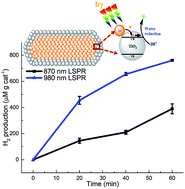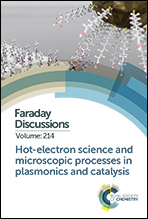Enhancing hot electron generation and injection in the near infrared via rational design and controlled synthesis of TiO2–gold nanostructures†
Abstract
Plasmonic nanostructure/semiconductor composites are receiving great interest as powerful photocatalytic platforms able to increase solar energy conversion efficiency compared to more traditional approaches. The possibility to grow a thin titania shell onto the gold nanoparticle, thus substantially increasing the metal–semiconductor area of contact, is expected to be ideal for photocatalytic water reduction, especially if the titania (TiO2) coating displays limited thickness and high crystallinity. We argue however that the morphology of the underlying gold nanoparticle and the quality of the interface are the main drivers of photocatalytic performance. Herein, we show how we can synthesize TiO2-coated gold nanostar- and gold nanorod-based photocatalysts and identify the most important design parameters that one should be focusing on for the optimization of hot electron-based photocatalysts. In addition to nanoparticle morphology and interface quality, we determine that the integrated absorptivity of the plasmon band and the uniformity and crystallinity of the semiconductor shell are important, even though to a lesser extent. These results may prove interesting not only to increase production rates in hydrogen evolution reactions or other chemical conversions, but also to decouple and understand additional mechanisms driving photocatalysis, other than the sequential, hot electron mediated one, as we reported before.

- This article is part of the themed collection: Hot-electron science and microscopic processes in plasmonics and catalysis


 Please wait while we load your content...
Please wait while we load your content...